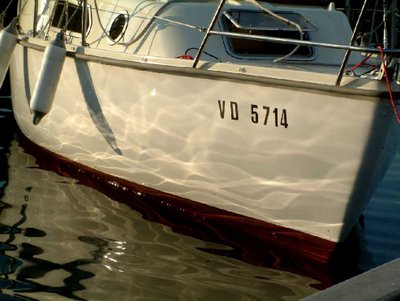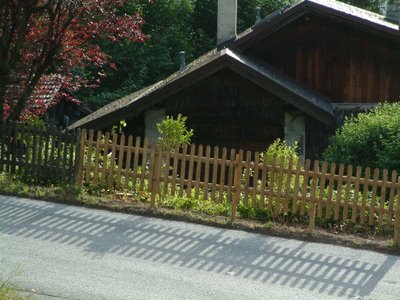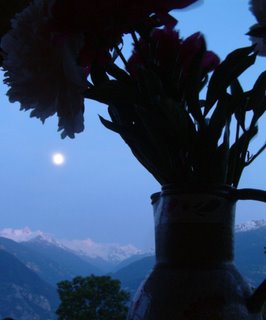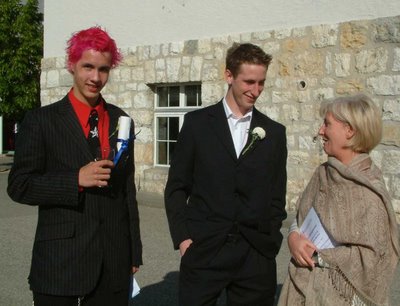The tricky business of photo sizes
Christopher, a garden professional in Hawaii, wrote a nice comment to my post about flowers listening and rocking.
He mentioned the tricky business of sizing photos. I worked as an editor for an education magazine for several years. We accepted photos from amateur photographers around the world and the one thing that seemed to confuse everyone was sizing digital photos. This became a little easier when we created an online photo database for the magazine because the photos were automatically resized. I learned a good deal before we reached automation, so I will share some of this.
Christopher is a good photographer and Christen in Massachusetts not surprisingly wants to make a copy of one of his photos. She politely asked him if she could.
In theory, the answer is yes. In reality, it won't work well. Here is why, with a few tips for managing digital photos.
The case of Christopher
Christopher recently posted a photo of his grandmother, taken in about 1915. He also posted shots of spectacular scenery in Hawaii, on the rainy side of Maui. If I right-click on any of these I get a menu with "properties" at the bottom. This tells me his photos are all 328x246 pixels. You don't need to know what pixels are, but if you're curious, wikipedia will tell you.
Think of pixels in relation to your computer screen's dimensions. The most popular size today is 1280x1024: 67% of the people visiting GenevaLunch, a community web site in Switzerland that I manage, have this size screen. An image that is 328x246 takes up about 1/4 of your screen - check it out.
Christopher's photos are therefore a good intermediate size, large enough to see but not so large that they take a long time to open on my computer.
If Christen tried to print these photos in a larger size they would start to go fuzzy. When Christopher posted his photos he had to select a size, just discussed, but also a resolution, or degree of sharpness. He might have done this in his blogging program, or maybe in a photo program like Photoshop. By default, resolution is usually set to 72dpi, or dots per inch, which is the maximum number most screens see - so there's not much point in going to a higher level, most of the time. We can look at a couple exceptions at the end.
The only way Christen can make a poster from his 328x246 pixels image is to ask him to check the size and quality of his original version of the photo. And that was determined by his camera settings when he took the photo.
Getting your photo sizes right
Step 1: your camera settings
Digital cameras have settings that you can change. Many of us forget this and slip into using the same one. For very special needs I use the high end of my camera's settings, called maximum, but that's rare. Mostly I set it on high rather than maximum, but I have only been able to do this since I started using a 512 MB memory card. With earlier cards of 128 MB I could only take a dozen photos at high resolution and then I had to dump them on the computer - not practical.
I take high resolution because I'm never sure how I might want to use these in the future. It's a precaution in case I want to print them. If I were only going to use photos on the Internet or a computer screen, I would not bother with the high resolution, since the very good quality is not apparent there.
A high setting means I get fewer photos for the same battery time and that the photos take longer to dump onto the computer, to upload to a blog or web site, to upload to flickr, where I usually put them.
Key question: what is the end use for these images?
This is the question that determines your camera setting. Who will look at these images, and where? Find the best compromise between good quality and practical size in terms of battery use and uploading time. Remember that very high quality photos are big, so anyone who wants to download them will be unhappy with you if they are too big.
Step 2: resizing the files once you dump the photos on your computer
I use Photoshop to do this. I occasionally use Microsoft Photo Editor, which is not as good.
Sizes for photos you plan to e-mail
Be kind: keep them small. I aim for 150-200KB photos if I have to send them by e-mail, for example family snapshots. I will send 800 or larger ones only to people I work with, knowing they have fast Internet lines and very good computers. Larger than 1MB I upload images to my web site or, if they can be public, to flickr, and ask people to download them there.
Sizes for blogs
Most blogs have built-in size limits. Blogger lets me choose one of three sizes, but just calls them small, medium and large. If I try to upload an image that is too large it will simply refuse the photo, but after spending 2-3 minutes trying to accept it. I learned this the hard way by trying to upload photos I had taken on the camera's high setting. The solution I use is to open the photos in Photoshop, go to image/resize and set them at 40-50% of their original size. Sometimes I forget to do this or I love the photo so I make it 60%, and Blogger accepts it but there is a problem. If you right-click on the photos on my blog you should normally be able to see a larger view of it. If the image I uploaded is too large, you can't see it - something Christopher experienced with some of my photos. He thought I had locked them: I simply forgot to make them a smaller size.
Sizes for web sites
You can improve the quality of web site photos somewhat by shooting them at a high quality, but then you should make sure you do not post them to the site at a high resolution. People visiting the site will not see any difference and the larger photos will slow down your site's loading time, which irritates visitors. I save web site images in Photoshop at high quality, not maximum. I try to keep images to 328x246 or on GenevaLunch I run some at 550 maximum on the longest side.
Sizes for prints
I rarely print photos so I'm not an expert here, but in general when you go from digital to print the better the quality of the original shot, the better the print, and print from a saved copy that is larger than the print you want to end up with.
Sizes for commercial printing, including posters, magazines, books
On my camera, a 3 year old Fuji Finepix, I can shoot at 8MB, but I usually shoot at 3 or 5. Why? Because although the quality at 8 is wonderful, it makes the camera painfully slow and one photograph can eat up the batteries. Also, no one sees the amazingly good photo because I mostly put my images on the web or in PC files. However, if you want to make great posters from a photo, this is the setting you need! If I think I will want to use the image in a magazine or book, I go for maximum quality.
Sizes for flickr or other photo-sharing groups
Flickr lets you set the maximum size you want to upload, and it adjusts your photos. Please walk through the four illustrations to this little photo lesson to see what happens when you vary the settings.
I recently saw a series of very large prints made by a wonderful young art photographer in Ireland, Richard Mosse (the Gulf one on his site doesn't begin to do justice to the print version). They covered half a long dining room table. He had invested his life's savings from his next three or four lives in a device that extends the capacity of a traditional Haselblad camera, beloved by professionals, to 40MB. This is a daunting level of quality. The photos he printed could simply not be shot by a regular good camera like mine. We cannot see the extraordinary detail that his prints show because your computer and mine are not sophisticated enough.
A final word: here is the limited-size image that Blogger should allow me to post of the bug photo. The bugs are part of the photo lesson set on flickr, mentioned above. Size: 30KB, 300x200, with resolution set at 72dpi, saved in Photoshop on high quality. So the quality is good but you can't view it very large. This might be a blessing. And Blogger just plain said no, for mysterious reasons. Sometimes no size suits!
 We had a very wild thunderstorm last night and this morning I tiptoed out to the garden in fear. Battered flowers, fallen stalks of fennel and tarrogon, at the very least.
We had a very wild thunderstorm last night and this morning I tiptoed out to the garden in fear. Battered flowers, fallen stalks of fennel and tarrogon, at the very least.




 Top to bottom: poppies and shasta daisies; columbine; daisy; rose; freesia; lily.
Top to bottom: poppies and shasta daisies; columbine; daisy; rose; freesia; lily.









































